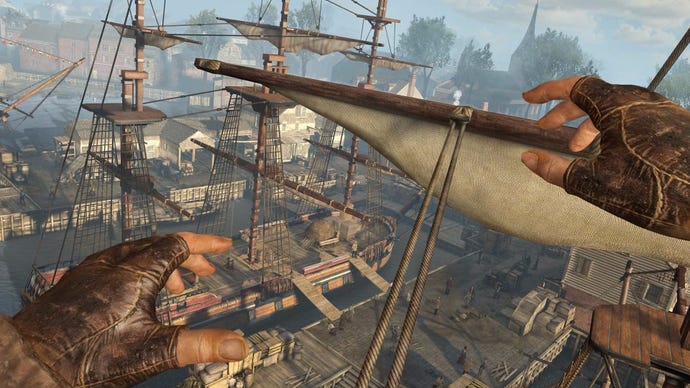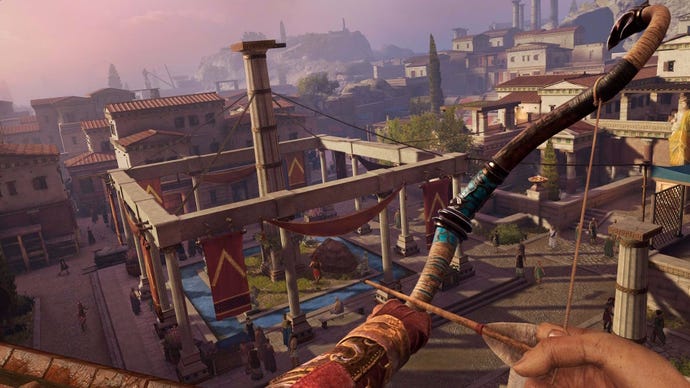Reality Bytes: Assassin's Creed Nexus features fantastic VR platforming, but crap combat
Bird's eye spew?
I'm in a weird place with the Meta Quest. It's really its own platform these days, with its own specs and increasingly divergent library of games. At the same time, the Meta's standalone headsets are by far the most popular PCVR devices. Therefore, most PCVR gamers will also have access to the Quest's handful of VR exclusives. Generally, this column sticks to covering games you can play with any PCVR headset, Quest or no. But since I reviewed the Meta Quest 3 last month, it feels odd not to check out at least one of its new titles, especially when it's probably the most notable VR release of the year – Assassin's Creed Nexus.
Also, I'll admit, a VR Assassin's Creed game intrigues me. The idea of cavorting across historical rooftops and shanking templars in the sternum sounds brilliant. It also sounds like barf city. Most VR games limit the need to move around as much as possible, so translating a game as kinetic as Assassin's Creed into VR seems mighty challenging.
Nexus, it turns out, makes a decent stab at this, successfully translating most of the series' hallmark mechanics into VR. However, this also means it brings over many of the series' foibles. Some of these are forgivable. Others, less so.

Aside from being in VR, Nexus differs from the mainline series in two ways. First, it isn't an open world game. Instead, it guides you through a linear sequence of small, open-ish areas similar to Dishonored (albeit with less freedom and attention to detail). Second, it doesn't introduce a new historical era. Instead, it divides its attention between three existing Assassins, namely the second game's Ezio Auditore, Odyssey's Kassandra, and Assassins Creed 3's Connor Kenway.
Typically, there's a modern-day plot threading all these together, but it is searingly hot nonsense. All you need know at the door is the story sees you alternate between your favourite series' protagonists (and Connor) and that you're gonna see Ancient Greece, Renaissance Italy, and Revolutionary New England in VR. For a longtime series fan, that's exciting, although the hardware limitations of the Quest mean this isn't as impressive as it would be if you could utilise the power of your PC. The open-world bubbles of Nexus are eye-catchingly designed, and while the open-world hubs aren't huge, they do have a certain amount of bustle, with a large number of NPCs wandering around. Up close, though, everything looks a bit Xbox 360. Building textures are flat, while those NPCs have a distinct mannequin-like quality.
This matters far less once you get moving, however. For the game's hallmark parkour, Nexus pinpoints the sweet spot between seamless movement and platforming challenge better than the regular series does. To hop across rooftops, you hold down the A button while sprinting and your feet will do the work for you. But anything to do with your hands, climbing, grabbing ledges, swinging between gaps, requires your active input.

This makes traversal slightly less swift, but more interactively satisfying. You can really get into a flow when dashing between objectives, but more substantial climbing challenges, like reaching the spire of Boston's church, or the roof of the Temple of Apollo, require you to actively search for handholds and maintain your grip with at least one hand. It isn't perfect - leaping between grapple points isn't as reliable as I'd like, and sometimes the game just won't register an action you've performed a million times, like hoisting yourself onto a rooftop. But it's an occasional problem rather than a constant nuisance.
Nexus also does well in VR-ifying many of Assassin's Creed's underlying systems. The game's equivalent of Eagle vision lifts your perspective to the sky, granting you diorama-like view of the 3D cityscape below. This is practical for planning routes, but it also makes great use of VR's powerful sense of scale. You can also perform the game's iconic leaps of faith from high places. These aren't quite as exhilarating as I'd hoped – the game puts a brake on your fall speed to stop your stomach from dropping – but they are still fun.
Where Nexus arguably surprises most is as a stealth game. Sneaking around the game's set pieces is not only possible, but intuitive and entertaining. Guard awareness is clearly communicated, and the game is consistent in how it tracks both how conspicuous you are, and the amount of noise you make. It also provides plenty of tools to deal with guards, such as a bow and arrow for distant kills, and throwing knives sheathed on your chest that you can quickly whip at a guard for a speedy dispatch. Both are fun to use. Admittedly, the game does most of the aiming work for you. But given the number of VR movements you need to master, I don't mind this too much. It certainly makes sense with the throwing knives. Flicking one from your wrist feels cool as fuck, and it encourages you to use them. You can also retrieve arrows and knives from bodies, which is similarly neat.


Then of course, there's your wrist blade (or blades, if you're playing as Ezio). These are extended by holding down the controller trigger, then flexing your wrist back, a satisfying if somewhat uncomfortable VR action. Using them to shank people is not as reliable as I'd like, however. There's quite a clear point at which the game takes control of the movement, as if your blade is magnetic and your target has an adamantine skeleton. If you move too fast, the stab doesn't always trigger, so instead of murdering your target you just slap them really hard on the back (sweet dreams, you piece of shit). Weirdly, drop-assassinations are generally more reliable, as you lock-on to the target before jumping, helping you time your stab better. You can also lure targets to haystacks for dispatch, and lurk beneath ledges to grab enemies by the ankles, both of which feel sufficiently devious.
In this way, Nexus is a better assassination game than a lot of the actual mainline games. Stealth is effective, taking down enemies is fun, and you can often approach your objectives from multiple angles. This is just as well, because when you're spotted and a fight breaks out, the experience turns to complete shit.
There's no sugar-coating it. The combat in Nexus honks. It derives heavily from the pre-Origins games, where enemies are basically invincible until you counter their attacks. Once you've blocked a strike, you can use the resulting opening to get a few hits in. Unfortunately, none of this feels good. Enemy attacks are so hilariously telegraphed it makes blocking them trivial, while your own attacks feel like whacking a punching bag with a pool noodle. There's no sense of connection whatsoever. Even if you whip out your wristblade during combat, it seems to bounce off your opponents rather than actually stabbing them.

It's as if the game is worried about being too violent, which I kind of understand. As a hugely popular series on its first VR rodeo, Ubisoft might not want to dwell on the interaction between sharp objects and flesh in the way that Blade & Sorcery does for fear of traumatising its players. Then again, the game is called Assassin's Creed. While I don't expect to be hacking people's limbs off and rolling around in the blood, I'm not here for cake and a cuddle either. It should feel satisfying to sink Connor's tomahawk into a Redcoat's dome, and it just doesn't.
There are other problems, too. The voice-acting in Nexus is surprisingly poor. Connor's VO is painfully wooden (which admittedly isn't that surprising). But Ezio also sounds like he's only just got out of bed, and a lot of the supporting VO is offputtingly flat. Only Kassandra has any life to her performance, so it's unsurprising that she's the most fun character to inhabit. Meanwhile, and this is a much pettier gripe, but the game puts too many menus between you and the action. You have to go through a calibration screen, the main menu, and the mission select screen each time you start. It means a lot of time hanging around in VR before you start playing.
Don't get me wrong, though, this is a respectable first attempt at distilling Assassin's Creed into VR. You'll find better versions of most of its systems in other VR games, and the combat flops harder than a panda at the public baths. But it's also much more comprehensive than a lot of VR experiences, and when everything comes together, it succeeds in making you feel like an apex ambush predator.







